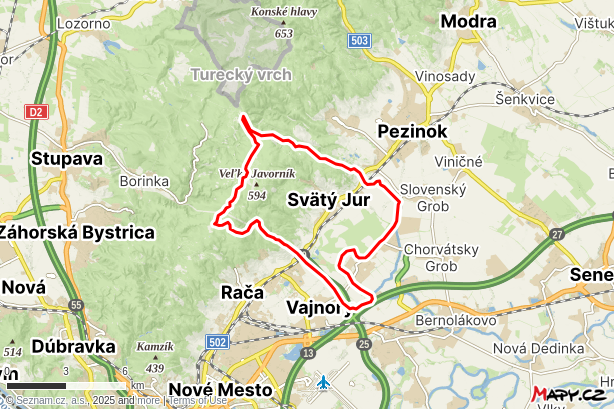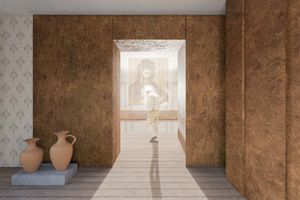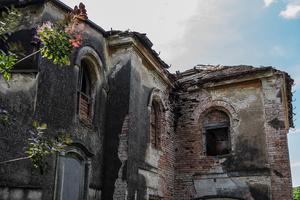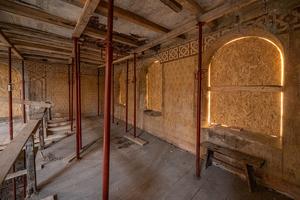Another monument will soon be added to the list of places that attract Orthodox Jews pilgriming, in the footsteps of renowned rabbi Chatam Sofer, to Bratislava. The Bratislava Self-governing region (BSK) has chosen a new design for a synagogue in Svätý Jur, a small town close to Bratislava especially known for wine production. During the Napoleon’s siege of Pressburg, present-day Bratislava, rabbi Chatam Sofer took refuge in Svätý Jur.
“The synagogue in Svätý Jur was threatened by extinction and we decided to buy and reconstruct it,” said Juraj Droba, head of the BSK. “Although the journey will be difficult, I believe that the result will be worth it.”
The goal of the BSK is to preserve the historical and cultural value of the building and to broaden its focus. It plans to comprehensively reconstruct this venue, extend it into a cultural centre and make it accessible to all the inhabitants of the region as well as visitors.
And the winner is…
The inconspicuous and forgotten synagogue in one of the side streets of Svätý Jur is a national cultural monument. Yet it was in a state of disrepair for many years and in danger of collapsing. In 2021, the BSK bought it and subsequently stabilised its structures and the roof. Then it acquired the neighbouring plot, enabling the building of amenities for the future culture centre.
Now the BSK is preparing a comprehensive restoration of the venue along with its extension. It first promulgated an architectural competition. From 18 submitted proposals, it selected the design of the Bratislava-based studio FVA led by Martin Vanko. The winner was announced in mid November 2024.
The jury appreciated the quality of the proposed public space that connects Pezinská and Mikovíniho Streets.
“The proposed pavilion on the border of the adjacent plot lets the reconstructed synagogue building stand out and create a variable space for the needs of the local community,” said Svetlana Waradzinová, head of the culture department at the BSK. She adds that the winning design was the one that most closely matched the BSK’s requirements. “It supports the historical significance of the synagogue, is sufficiently variable from an operational point of view, and reversible in terms of heritage.”
The refurbished synagogue is intended to mainly serve as a cultural and community centre, but is expected to attract the attention of the Jewish community thanks to the figure of rabbi Chatam Sofer. Part of the synagogue will house a museum dedicated to him.
The estimated cost of the refurbishment is approximately €1.3 million. The BSK would like to finance it from external sources. It has not specified when the refurbishment would be completed.
“We have all of 2025 to prepare the project documentation, we have to get permits,” Patrícia Mešťan, director of the BSK’s office, told The Slovak Spectator.
Synagogue served as utility building
The synagogue in Svätý Jur, one of the oldest in Slovakia, stands on the Svätý Jur Municipal Monument Reserve. It was founded in 1790 in a former 17th century manor house called Edlhof. In 1876 it was enlarged and rebuilt in the spirit of architectural historicism. During Napoleon’s siege of Bratislava in 1809, the renowned Orthodox rabbi Chatam Sofer (Moshe Schreiber), a leading figure of the Bratislava Jewish community, found refuge in Svätý Jur, just 15 km from Bratislava. He continued his rabbinical activity here, thus contributing to the spiritual life of the local Jewish community.
The synagogue ceased to serve its purpose in 1942. During the Second World War it was the target of vandalism. After the war it became a utility building, subjected to inappropriate interventions and gradually fell into disrepair. Nevertheless, several valuable elements have been preserved: the stone walls, wall paintings and a piece of the original pavement, which will be used to reconstruct it.
Jewish legacy reflected in the design
The synagogue has already undergone archaeological and restoration research and the BSK has binding opinions from the Regional Monuments Office.
“Part of the jury’s decision-making process included an expert from the Regional Monuments Office, who did not have voting rights, but in the first round he gave the office’s opinion on each proposal, which we have to respect,” said Waradzinová.
When readying the synagogue’s reconstruction, it was also taken into account how the resulting buildings would fit in with the surrounding small-town development. In its neighbourhood, the municipal office is planning the restoration of the Staromlynský brook, where a pedestrian zone should be created.
The Jewish community appreciates the fact that they were involved in the decision-making process.
“We were invited to supply an expert to the commission, the academic sculptor and restorer Tomáš Lupták, with whom we have long cooperated on the restoration of synagogues,” said Martin Kornfeld, secretary of the Central Union of Jewish Religious Communities.
The jury also included architect Martin Kvasnica, who designed the Chatam Sofer memorial in Bratislava.
According to jury chair Eva Eichlerová, the best designs in the competition took two approaches.
“On the one hand, the creation of an unpretentious, playful community space and, on the other hand, a lavish, generous and high-quality architecture that is more akin to a monument, but will not be used as much by the local community,” she said. “The jury favoured the first approach.”
Since the synagogue has no social facilities or facilities for cultural events, the competition proposals should have included a new building to provide them. It was important that it not overshadow the synagogue.
The competition was particularly stimulating for the FVA studio due to the history of the Jewish community.
“Many important Jewish buildings were demolished in Slovakia, so we started to deal with this issue. We felt the need to fully preserve and enhance this monument,” Martin Vanko of the FVA studio told the ASB magazine, adding that they visited synagogues in Trnava and Senec. The Senec synagogue has also been renovated by the BSK, a cultural monument that commemorates the past of the Jewish community and also preserves a mikveh ritual bath or a brick oven.
Significant architectural elements, customs and traditions of the Jewish faith were important to FVA in designing the project in Svätý Jur. One of these is the synagogue’s orientation towards Jerusalem.
“The Torah, the holy scripture of Judaism, is placed on this main compositional axis,” said Vanko. “This layout concept can also be seen in the exhibition dedicated to Chatam Sofer, which is proposed on this axis.”
The architects designed a pavilion that stretches along the neighbouring plot, not leaning on the synagogue building in any part, leaving the renovated building to stand out. The individual partitions can be rotated and opened, making the space more open, or conversely, more intimate. It provides space to change functions throughout the year.
“From an operational point of view, it is very variable, the structure is reversible, easy to retrofit or demolish,” said Waradzinová.
Persona of Rabbi Chatam Sofer
Chatam Sofer (1762-1839), whose original name was Moshe Schreiber, is one of orthodox Judaism’s most significant scholars, described by www.chatamsofer.sk as “world renowned for his comments on the Talmud and Tora, and the founder of conservative Pressburg’s yeshiva, one of the most prominent centres of traditional Jewish learning in Europe”.

The Chatam Sofer memorial in Bratislava, considered by many to be the second holiest place after Jerusalem, is a Jewish burial shrine built over the graves of prominent rabbis and scholars, including that of Chatam Sofer himself. This is the sole remaining part of the Jewish cemetery used until 1847, which was destroyed in 1943 during construction of the nearby tunnel.
The current memorial is a result of an extensive re-development of the site from 2000-02 – a project by the Slovak architect Martin Kvasnica, who followed the strict requirements of the halakhah (Jewish law) when designing the monument. The memorial opened in 2002 on the 240th anniversary of Chatam Sofer’s birth.
“Chatam Sofer is still revered today as one of the world’s greatest rabbis,” said Mešťan. “After the restoration of the synagogue in Svätý Jur, we expect this place to attract the attention not only of the Jewish community, but also of the general public from all over the world. The synagogue will become not only a symbol of spiritual heritage and a reminder of an important period in Jewish history, but also a living cultural space.”


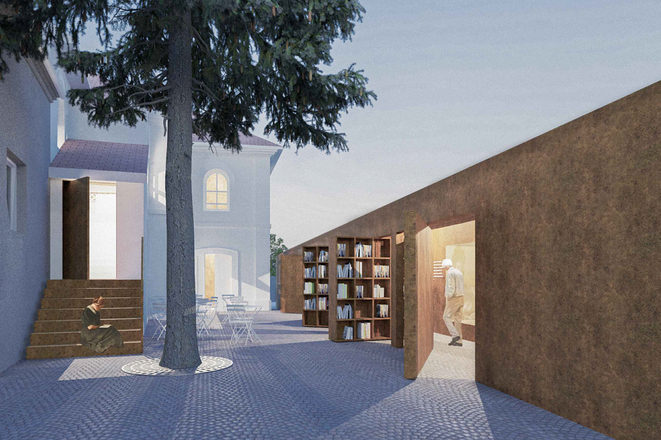 The visualisation of the proposed design of the refurbished synagogue in Svätý Jur. (source: FVA)
The visualisation of the proposed design of the refurbished synagogue in Svätý Jur. (source: FVA)
